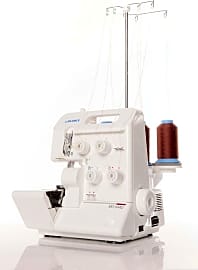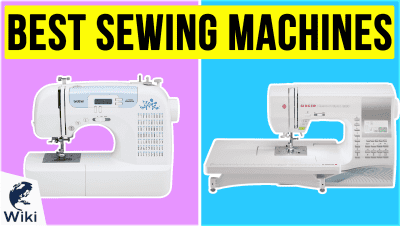The 10 Best Sergers

This wiki has been updated 41 times since it was first published in February of 2015. Sew, trim, and finish seams in a single step with one of these versatile sergers, each of which is capable of a wide variety of stitches. Whether you are a home hobbyist or a professional seamstress, these machines can help you make durable and decorative edges and trims, and they're especially great on tough-to-finish stretchy fabrics. Offered in a range of prices, there is one for every budget. When users buy our independently chosen editorial picks, we may earn commissions to help fund the Wiki.
Editor's Notes
January 07, 2020:
After some consideration, we have decided to keep the Juki Pearl Line MO-655. It is both expensive and not the best choice for beginners, but for those who already have experience with Juki machines, it may be a good option, especially since its heavy-duty knife and automatic rolled hemming make it quite versatile. Experienced users might also consider the Singer Professional 5 and its wide variety of stitch options. For those who are new to using a serger, we added the Bernette Funlock 44, which has just enough features to be useful, but not so many that it feels overwhelming. And, finally, when it comes to the option that's hard to beat, we still like the Brother 1034D. Its price ensures that most can buy one to complement a sewing machine, and it has plenty of nice touches, from the removable free arm to the 1,300 stitch-per-minute speed.
Special Honors
Husqvarna Viking Huskylock S25 If you can dream it, you can probably create it with the help of the Husqvarna Viking Huskylock S25, a robust machine with a large sewing space and a handy display that shows you the stitch you've selected in its actual size. Offering professional results, it isn't exactly inexpensive, but in experienced hands it is worth the cost. husqvarnaviking.com
Juki MO-1000 Few people really enjoy threading their machines, a task that is made less taxing thanks to the Juki MO-1000. It boasts an air threading feature that uses a whoosh of air to thread the looper, which is complemented by an automatic needle threader. It's relatively quiet in operation, too. jukihome.com
Baby Lock Accolade The Baby Lock Accolade allows you to work with up to eight threads at a time, and it has ExtraordinAir threading that uses a puff of air to thread all three loopers at one go. It's a little heavy at 21 pounds, but it is made for the long haul and to give you the professional results you desire. babylock.com
The Serger Advantage
There is a wide range of special stitches that can be performed with a serger.
A serger is a special type of sewing machine that is designed to perform a specific task. It will not replace your regular sewing machine, so don’t think that you can buy a serger and create full garments.
Sometimes known as an overlock sewing machine, the serger creates a special stitch on the hem or seam of nearly any type of fabric you can imagine. It is a great choice for sewing with knit fabrics because the material is stretchy and often difficult to manage by hand or with a regular sewing machine. It is especially useful if you want to get fancy and add decorative details to your fabrics.
There is a wide range of special stitches that can be performed with a serger. Some sergers are capable of one or two of these stitches while the higher end models can do it all. These stitches are the four-thread overlock, the three-thread overlock, rolled hemming, ribbon lock, narrow hemming, pin tucks, blind hemming, and flat lock. The final three require an optional foot to achieve.
At this point, you might be wondering if you even need a serger. If you are just picking up sewing as a new hobby and don’t plan to sew complicated pieces or stitches, you probably will be fine with a regular sewing machine.
However, if you sew frequently and if you enjoy creating new pieces, or if you sew costumes for your child, a serger is going to make your life much easier. If you are a professional seamstress or have aspirations of selling some of your creations, a serger will give your work a professional look and save you a great deal of time. Some sergers are capable of sewing up to 1500 stitches per minute.
Don't Skimp On Quality
Once you have established that you do, in fact, want to purchase a serger, trying to decide between the available options can be daunting to say the least. Obviously, the features you need will hinge on your purpose for the serger. Decide on your intended use, and then you will have a clearer picture of what you need.
First, consider the number of threads. We recommend that you look for a serger that has at least four threads because this is going to make for stronger, more reliable stitches. This is especially important if you are sewing garments. If you are simply stitching some pillowcases, sheets, or the occasional hem, the thread count is not quite as important.
Decide on your intended use, and then you will have a clearer picture of what you need.
Second, check for adjustable settings such as stitch length and width and adjustable sewing speed. The more adjustment options available, the more versatility you will have when sewing hems and edges. Also make sure that it is easy to adjust the seam width on your chosen machine.
Third, make sure that the presser foot is easy to adjust so you can thread more easily. Threading a serger requires a bit of a learning curve, and the easier you can make the process, the better. Also ensure that the pressure on your presser foot is adjustable so you have a wider range of sewing options and that the thread tension is released when the foot is raised.
Next, check for color coded threads. This will make your life much simpler. Because serging requires three or more needles, it can be difficult to track exactly what threads go where. A color coded threading path will take some of the guesswork out of it, especially if you are a beginner.
Some other options to look for in a high quality serger are a sewing light, seam gauge, a high quality blade., and a built-in thread cutter. All of these elements add convenience and simplicity to what could otherwise be a time-consuming, tedious job.
Finally, as with every product you intend to purchase, consider your budget. A serger can be an expensive purchase, especially if you are a novice. While the higher-end sergers tend to have the most features, more expensive isn’t always better. Depending on your intended use, you might be better off with a less expensive serger that can provide the basics while you learn the ropes.
A Brief History of the Serger
The Merrow Machine Company invented overlock stitching or "serging" in 1881. J. Makens Merrow and Joseph Merrow, father and son, opened a knitting mill in Connecticut in 1838. They invented a wide range of machines to aid in sewing and garment making including a machine that could be used for crochet stitching. This later evolved into the overlock machine which Joseph Merrow patented in 1889.
They invented a wide range of machines to aid in sewing and garment making including a machine that could be used for crochet stitching.
Instead of using a bobbin like many sewing machines, the overlock machine creates loops through which the needle can thread and create a strong stitching similar to what happens when crocheting. The company spent time through the years creating a wide variety of sergers that produced many different types of overlock stitches.
Japanese engineers and middle managers working for a Japanese company in 1964 developed an idea to design and market smaller sergers for at home use. Their idea was shot down by their current company, so they left their jobs to form the Juki Corporation. This is when the Baby Lock was created giving the average person the convenience and ability to produce a manufacturer’s quality overlock seam in the comfort of their own home.
The Tacony Corporation, under the guidance of founder, Nick Tacony, introduced the Baby Lock to the United States so the average person could avoid the inconvenience of trying to finish seams with an average sewing machine and save a lot of time and frustration.















